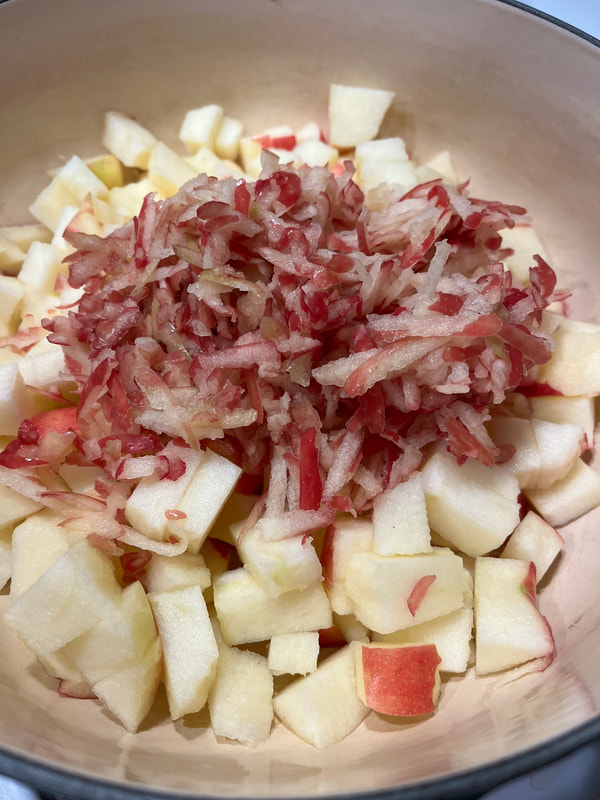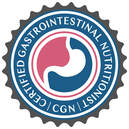|
Although you have probably tried many butternut, delicata, and spaghetti squash recipes, you likely haven't tried this winter squash variety yet. Kuri squash is by far my favorite choice for soups because it delivers this beautiful bright orange, creamy soup, that other squash varieties just can't meet. Plus, this soup is rich in fiber and polyphenols because you can eat the peel of the squash unlike many other squash varieties. You can find Kuri Squash at your local grocery store or Farmer's Market. Kuri squash also tastes great as an alternative for pumpkin pie. Since this soup is low in protein, I highly recommend pairing it with a protein rich food. For example a salad topped with grilled chicken breast or burger patty, a tuna sandwich, or simply cut in some leftover cooked protein when reheating a serving.
Coconut Ginger Red Kuri Soup INGREDIENTS 1 small Red Kuri squash 1 medium yellow onion 1 medium apple 2 inches ginger root 4 cloves garlic 1 tablespoon olive oil 1/4 teaspoon sea salt 1 can organic coconut milk 2 teaspoons Better than Bouillon Organic Vegetable paste Juice of 1/2 to 1 lemon Fresh ground pepper to taste Optional: chili flakes DIRECTIONS Cut the kuri squash in half and remove the seeds. Then cut into quarters. Steam the squash in a steamer basket over medium heat until tender when pierced with a fork, about 15-20 minutes. Allow to cool enough to handle. Chop into chunks. Meanwhile, prepare the remaining ingredients. Peel the onion and dice. Chop the apple into chunks, leaving the skin on. Peel and dice the ginger root and garlic cloves. In a large soup pot, heat olive oil over medium heat. Once hot add the prepared veggies, reduce heat to medium low, stir in 1/4 teaspoon sea salt, and saute until onions are glassy. Then pour in the can of coconut milk. Fill up the empty can of coconut milk with water and add that to the veggies as well. Add the Better than Bouillon, and add the coarsely chopped kuri squash and stir to combine. Increase heat to medium high and bring the soup to a simmer. Reduce heat to medium low and simmer for ~10 minutes. Then remove from heat and puree with an immersion blender. Add fresh ground pepper and lemon juice to taste, starting with the juice of 1/2 lemon and increasing to taste. Season with additional salt and chili flakes if desired.
0 Comments
Homemade Applesauce with a Special Twist
Most people peel their apples when making applesauce to keep the texture nice and smooth. But in the process they are discarding the most nutritious part! The apple peel is rich in gut loving and anti-inflammatory polyphenols including well known quercetin. Quercetin is most well known for inhibiting the production and release of histamine, thereby reducing the severity of seasonal allergies and other histamine related symptoms. The peel is also an excellent source of pectin a soluble fiber which can soothe the GI tract and can be especially helpful when struggling with diarrhea. Pectin is also fermented by good gut microbes and therefore helps support a healthy and diverse gut microbiome. Since we are keeping the peel on for this applesauce, it becomes increasingly important to choose ORGANIC apples, as conventional apples are highly sprayed with pesticides. And to help improve texture of applesauce, I recommend grating the apple peels instead of just coarsely chopping the apples. Although this is an extra step, it allows the apple peel to easily dissolve during the cooking process, leaving the texture more smooth. With the addition of the skin, and the increase in polyphenols and pectin, the applesauce is pinker in color and is thicker in texture. However, apples are rich in fructose and sorbitol, two kinds of sugars that are considered FODMAPs. If you don't tolerate either of these well, then applesauce (and apples) may trigger uncomfortable digestive symptoms until the underlying cause is addressed, such as SIBO (small intestinal bacterial overgrowth), which can lead to fructose malabsorption. Some people unfortunately, struggle with hereditary fructose intolerance, and will have to limit fructose entirely to avoid uncomfortable symptoms. Applesauce INGREDIENTS Organic apples Filtered water Lemon juice Spices (fresh ginger root, cinnamon, vanilla, etc) Sea salt Sweetener of choice (optional) - depending on the type of apple you may need more of less DIRECTIONS Wash your apples and grate the peels. Cut out the core and dice up the remaining apple flesh. Add the grated peels, apple bits, water, lemon juice, and your choice of spices to a large pot, cover, and bring to a simmer. Simmer until tender, about 15-20 minutes depending on the size of the chunks. Remove lid, and mash with a potato masher or whisk, stir in salt, and optional sweetener to taste. You may continue to simmer uncovered for a couple of minutes to evaporate excess water if needed until desired texture is achieved. Transfer to a sealable glass jar and enjoy. I love it with Nancy’s whole milk yogurt or cottage cheese. Show me your applesauce making skills!! Bread....so comforting yet so convoluted in the gut health arena. If your struggling with digestive issues it's likely you have had to avoid bread or swap traditional breads with gluten-free alternatives. Unfortunately, most gluten free bread out there is S H I T. Firstly, the quality is horrible and secondly it tastes like nothing. So I made it my mission to make a bread that was 1) easy to make, 2) highly nutritious and delicious, and 3) gut friendly. So are you ready?? The Gut Friendly Loaf is THE BREAD for all you folks struggling with gut issues. Why is that?? Well firstly, it is prepared from raw, organic gluten-free grains (not flours). When grains are soaked in acidic water an enzyme called phytase is activated which breaks down phytates. Phytates can be irritating to an inflamed gut and can bind to minerals in our food. However, folks with good gut health and good gut microbiome diversity can tolerate a higher phytate diet because lactobacillus and other bacterial species can produce their own phytase. Most folks with gut issues already struggle with malabsorption and have dysbiosis. Therefore they often find symptom improvement on grain free diet likely because of previous high consumption of poorly prepared grains & flours. Unfortunately, the amount of phytase found in grains is reduced when they are ground to flour because phytase is easily destroyed by high temperatures. Also the longer the flour is stored, the less phytase there is. Optimally flours are ground fresh, soaked and/or fermented, and used immediately. Today convenience often takes precedence over proper preparation. If you are interested in learning more check out this article from the Weston A Price Foundation. Interestingly, buckwheat (a gluten-free pseudo-grain) naturally contains very high amounts of phytase, whereas quinoa does not. Therefore, combining the two grains during the soaking process allows you to reap the benefits of both. Both quinoa and buckwheat when properly prepared are high in plant protein, fiber, and minerals. Plus, they are both considered low FODMAP, which means individuals with IBS and SIBO are likely to tolerate them, especially if properly prepared. Secondly, the bread is bound with chia seeds (also low FODMAP) in place of eggs or gums which often are not tolerated in gut sensitive individuals. Plus, this bread does not contain yeast, which also can be a common food trigger, and instead baking soda is used for leavening. And finally, this bread is naturally gluten-free and dairy-free, which also helps many. So with a lot of thought and care I have developed this recipe to serve you in the best of ways. If you have been avoiding grains or eating refined non-organic gluten-free breads, then it's time to give this Gut Friendly Loaf a try. Perhaps it will help bring back more joy to your plate and to your palate and even connect you more with your food. It is simple, nutritious, and very satisfying especially when toasted. I personally love it toasted with butter and local honey or I make open faced sandwiches. Follow me on Instagram for more fun ways to use this bread. Anyways, this is my holiday gift to you, your welcome! Buckwheat Quinoa Chia Bread
Makes ~16 slices or 8 servings INGREDIENTS 1 cup organic tan quinoa 1 cup organic raw buckwheat grouts Filtered water 1 tablespoon apple cider vinegar ¼ cup chia seeds 1 cup filtered water, divided 2 tablespoons lemon juice 2 tablespoons olive oil ½ teaspoon Redmond’s Real Sea Salt 1 teaspoon baking soda DIRECTIONS Place the quinoa and raw buckwheat grouts into a large glass or ceramic bowl, cover generously with filtered water, and stir in apple cider vinegar. Cover with a clean kitchen towel and let soak overnight or at least 12 hours at room temperature. Strain the soaked grains in a colander and rinse well. Allow the excess water to drain for about 5 minutes. Meanwhile, preheat oven to 350 degrees and mix the chia seeds with ½ cup filtered water. Stir with a fork and allow to gel, about 5-10 minutes. Meanwhile prepare your loaf pan and line with parchment paper. See the video here for instructions. Ideally use a small Pullman pan, but a typical banana bread loaf pan works too (you just may need to bake it a little longer). Once your grains are strained and your chia seeds are soaked you are ready for the next step. Transfer the strained grains into a high speed blender (I use a BlendTec) or food processor and add ½ cup filtered water, lemon juice, 2 tablespoons olive oil, and ½ teaspoon sea salt. Process until the mixture starts to become a batter and the blade runs well. Add the chia seeds and process some more until most of the quinoa seeds are blended but not all. Keeping some of the texture allows for a better rise. Finally, add the baking soda and pulse until well combined. Then transfer bread batter into the loaf pan and gently (not deeply) slice diagonal lines or X’s across the top to allow for a more uniform rise. Bake for 90 minutes at 350 degrees or until inserted toothpick comes out clean. Remove from pan, remove parchment paper, and allow to cool on cooling rack completely before cutting. Store in the refrigerator for a week. Nutrition Per Serving (2 slices): 200kcal, 30g carbs, 7g fat, 5g fiber, 6g protein. Note: If you cannot tolerate quinoa, millet or sorghum will likely work too. However, I have not tried this combination yet. Please let me know how it goes if you experiment. Alternatively, use 100% buckwheat. |
RecipesI hope you enjoy my creative, flavorful, and nutrient dense approach to whole foods cooking. All recipes are gluten free. Archives
December 2022
Categories
All
|








 RSS Feed
RSS Feed


